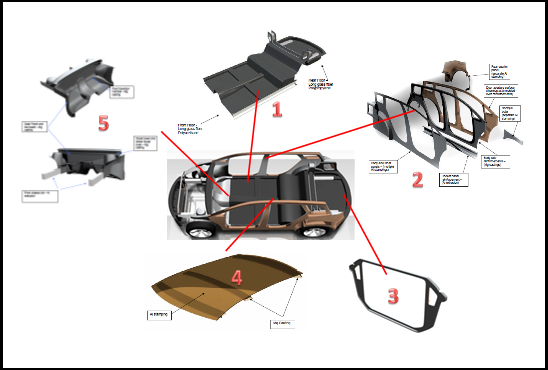Main Article Content
Abstract
Depletion of fossil fuels and greenhouse gases is an essential issue in the development of the automotive industry. From the design stage, material selection becomes the most crucial factor. Therefore, this article discusses the development of lightweight automotive materials for increasing fuel efficiency and reducing carbon emissions. Material reliability is assessed by how much weight reduction can be achieved, production costs, safety and durability. Ferro materials (mild steel, High Strength Steel, and Advanced High Strength Steel), non-ferrous (aluminium and magnesium alloy), and Fiber Reinforced Plastics (FRP) have been proven to reduce the total weight of vehicles up to 12.6%. Confirmation of statistical data from the literature illustrates the possibility of using lightweight material to achieve zero CO2 emission. In addition, the 12.6% weight reduction still meets the vehicle safety factor.
Keywords
Article Details
References
- B. Dudley, “BP Statistical Review of World Energy Statistical Review of World,” 2019. [Online].
- S. C. Davis, S. W. Diegel, and R. G. Boundy, Transportation Energy Data Book: Edition 32. Oak Ridge: Center for Transportation Analysis Energy and Transportation Science Division, 2013.
- V. Ferreira et al., “Technical and environmental evaluation of a new high performance material based on magnesium alloy reinforced with submicrometre-sized TiC particles to develop automotive lightweight components and make transport sector more sustainable,” Journal of Materials Research and Technology, vol. 8, no. 3, pp. 2549–2564, 2019.
- D. Jasiński, J. Meredith, and K. Kirwan, “A comprehensive framework for automotive sustainability assessment,” Journal of Cleaner Production, vol. 135, pp. 1034–1044, 2016.
- R. R. Rajagopal, R. Rajarao, S. T. Cholake, and V. Sahajwalla, “Sustainable composite panels from non-metallic waste printed circuit boards and automotive plastics,” Journal of Cleaner Production, vol. 144, pp. 470–481, 2017.
- A. Giampieri, J. Ling-Chin, W. Taylor, A. Smallbone, and A. P. Roskilly, “Moving towards low-carbon manufacturing in the UK automotive industry,” Energy Procedia, vol. 158, pp. 3381–3386, 2019.
- D. Verma and I. Senal, “6 - Natural fiber-reinforced polymer composites: Feasibiliy study for sustainable automotive industries,” in Woodhead Publishing Series in Composites Science and Engineering, D. Verma, E. Fortunati, S. Jain, and X. B. T.-B. Zhang Biopolymer-Based Materials, and Bioenergy, Eds. Woodhead Publishing, 2019, pp. 103–122.
- J. Pruez, S. Shoukry, G. Williams, and M. Shoukry, “Lightweight Composite Materials for Heavy Duty Vehicles,” Morgantown, West Virginia, 2013.
- Government of Canada, “Vehicle weight | Natural Resources Canada,” Natural Resource Canada, 2018. .
- H. Saidpour, “Lightweight High Performance Materials for Car Body Structures,” in NTI Technology Conference, 2004, vol. 16, no. June, pp. 14–19.
- S. S. Yang, N. Nasr, S. K. Ong, and A. Y. C. Nee, “Designing automotive products for remanufacturing from material selection perspective,” Journal of Cleaner Production, vol. 153, pp. 570–579, 2017.
- P. M. Horton, J. M. Allwood, and C. Cleaver, “Implementing material efficiency in practice: A case study to improve the material utilisation of automotive sheet metal components,” Resources, Conservation and Recycling, vol. 145, pp. 49–66, 2019.
- N. Sakundarini, Z. Taha, S. H. Abdul-Rashid, and R. A. R. Ghazila, “Optimal multi-material selection for lightweight design of automotive body assembly incorporating recyclability,” Materials & Design, vol. 50, pp. 846–857, 2013.
- Lotus Engineering Inc., “An Assessment of Mass Reduction Opportunities for a 2017 – 2020 Model Year Vehicle Program,” 2010.
- OICA, “2010 Statistics | OICA,” oica.net, 2010.
- G. Krauss, “Heat Treatment of Ferrous Metals,” in Reference Module in Materials Science and Materials Engineering, Colorado: Elsevier, 2016, pp. 3132–3134.
- D. R. Askeland, P. P. Phulé., and W. J. Wright, The science and engineering of materials, 4th ed. Ontario, Canada: Thomson/Brooks-Cole, 2003.
- Harding and R. A., “The production, properties and automotive applications of Austempered Ductile Iron,” Kovove Materialy, pp. 1–16, 2007.
- J. R. Keough and K. L. Hayrynen, “Automotive applications of austempered ductile iron (ADI): A critical review,” SAE Technical Papers, 2000.
- M. Y. Demeri, Advanced High-Strength Steels. Ohio: ASM International, 2013.
- S. Keeler and M. Kimchi, Advanced High-Strength Steels Application Guidelines V5, 5.0. Word Auto Steel, 2014.
- G. Phoenix, “World Auto Steel: AHSS Insight,” ahssinsights.org, 2018.
- L. Arnberg, “Solidification of Light Metals (Non-Ferrous),” in Materials Science and Materials Engineering ISBN 9780128035818, Elsevier, 2017.
- W. S. Miller A et al., “Recent development in aluminium alloys for the automotive industry,” Material Science and Engineering: A, vol. 280, no. 1, pp. 37–49, 2000.
- M. K. Kulekci, “Magnesium and its alloys applications in automotive industry,” International Journal of Advanced Manufacturing Technology, vol. 39, no. 9–10, pp. 851–865, 2008.
- International Magnesium Association, “Automotive Application,” 2016. [Online].
- R. Stewart, “Lightweighting the automotive market,” Reinforced Plastics, vol. 53, no. 2, pp. 14–16, 18–19, 21, 2009.
- J. Komornicki, L. Bax, H. Vasiliadis, I. Magallon, and K. Ong, Polymer composites for Automotive Sustainability. SusChem http://www.suschem.org/, 2017.
- A. K. Kaw, Mechanics of Composite Materials., 2nd ed. Boca Raton, Florida, USA: CRC Press, Taylor and Francis Group, 1984.
- H. Shercliff and M. Ashby, “Elastic structures in design,” in Reference Module in Materials Science and Materials Engineering, Amsterdam: Elsevier, 2016.
- R. Sun, “Review of multifunctional composites in automotive applications,” bris.ac.uk, 2014.
- G. Refiadi, Y. Syamsiar, and H. Judawisastra, “The Tensile Strength of Petung Bamboo Fiber Reinforced Epoxy Composites : The Effects of Alkali Treatment,” in IOP Conf. Series: Materials Science and Engineering 547 012043, 2019, pp. 1–10.
- T. Ishikawa et al., “Overview of automotive structural composites technology developments in Japan,” Composites Science and Technology, vol. 155, pp. 221–246, 2018.

